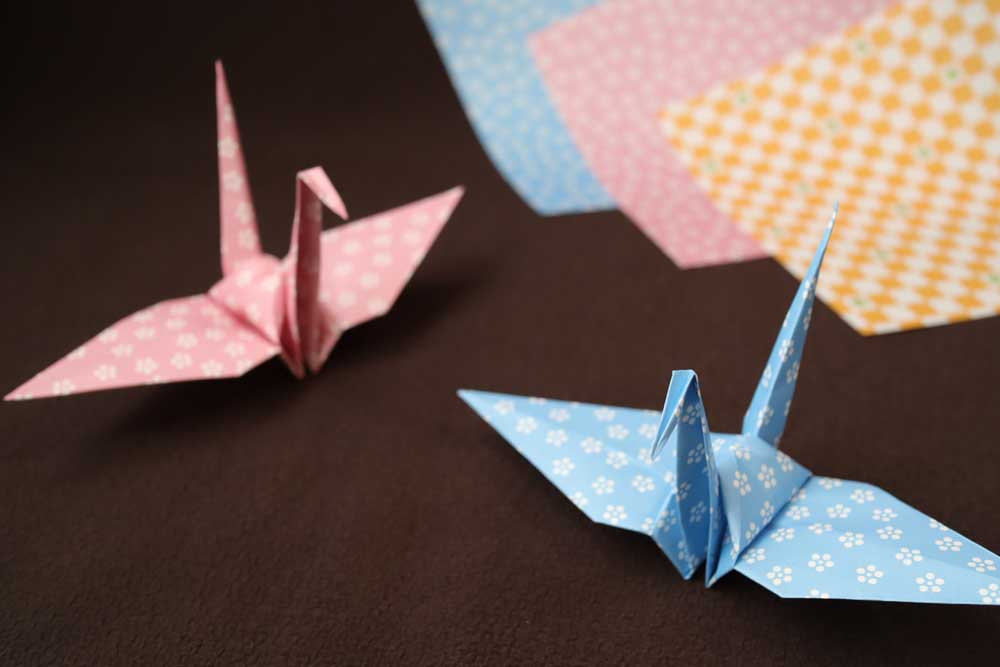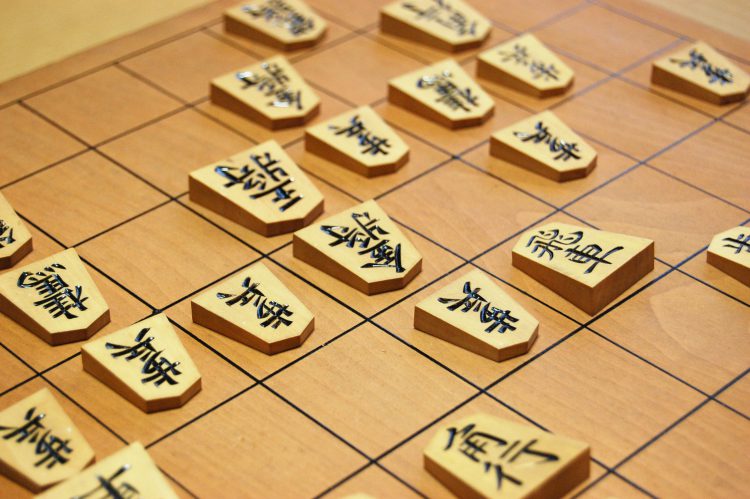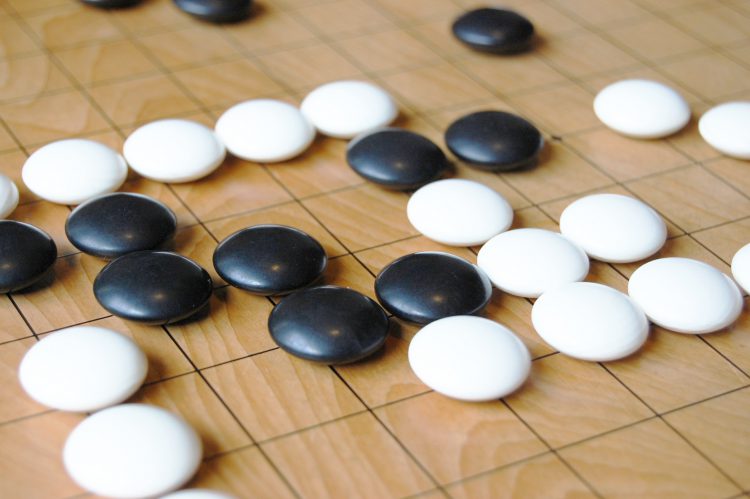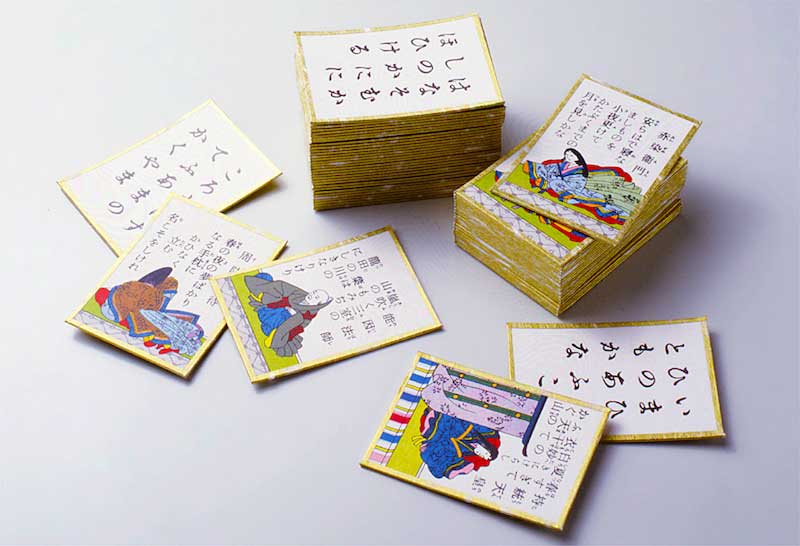
英語で説明する将棋、 囲碁 に続き、今回は日本の伝統的な遊びである「かるた」「百人一首」「花札」「羽根突き」「けん玉」「お手玉」などを英語で説明する表現をご紹介していきます。
どんな遊びにも、先人たちの知恵と工夫がぎゅっと詰まっており、集中力、記憶力、動体視力、状況判断力などが自然と鍛えられたりするので、皆さんも大いに遊んで、異文化交流を楽しんでいただければと思います。
ご興味のある方は、当サイトで 英語クイズ(5000問) を出題しておりますので是非ご覧ください。
目次
かるた
かるたは英語で traditional Japanese playing cards といいます。
子供が文字や単語を覚えたりするのに役立つほか、大人の集中力を鍛えたりすることが出来るといわれており、古くから老若男女に親しまれています。
Karuta playing cards consist of two types of cards with pictures or writing drawn on them.
(かるたは、読み札と絵札の2種類の札から成るカードゲームです。)
“Iroha karuta” is the most traditional version.
(「いろはかるた」は、最も伝統的なかるた です。)
The reading cards are printed with proverbs.
(読み札にはことわざが書かれています。)
The picture cards have illustrations of the same proverbs.
(絵札は、同じことわざの絵が描かれています。)
When playing, the dealer reads out “yomifuda” (a reading card) and the other players compete to get “efuda” (a picture card) that matches it.
(遊ぶときは、1人が読み札を読み上げ、他の人がそれに合う絵札を競い合って取ります。)
The player who takes the most cards is the winner.
(最も多くの札を取った人が勝ちとなります。)
The name “karuta” came from the Portuguese word meaning “card.”
(かるたという名前は、ポルトガル語でカードを意味する語に由来します。)
百人一首
鎌倉時代初期の歌人、藤原定家の私撰による代表的歌人100人の和歌が、江戸時代に「絵入り歌がるた」として普及したものです。
ふつう百人一首というと、この「小倉百人一首」を指します。
Hyakunin-isshu generally refers to the poetry anthology entitled Ogura-hyakunin-isshu that a poet named Fujiwara Teika compiled by choosing a tanka (poem) for each one of the one hundred outstanding poets from collections of waka poems such as Kokinshū, Shinkokinshū and so on.
(「百人一首」とはふつう、歌人の藤原定家が、「古今集」「新古今集」などの和歌集の有名な歌人100人から、1人1首ずつ和歌を選んでまとめた「小倉百人一首」のことをいいます。)
From the time of the Edo Period, it became popular as poem cards with pictures.
(江戸時代には、「絵入り歌がるた」として普及しました。)
The poets express their thoughts of love, nature, and the seasons with a beautiful refinement.
(歌人たちは、恋愛、自然、四季などに対する想いを美しく繊細に表現しています。)
Even now, a championship tournament of Hyakunin-isshu is held during New Year’s days in Japan.
(現在でも、日本ではお正月に百人一首の選手権大会が開催されています。)
花札
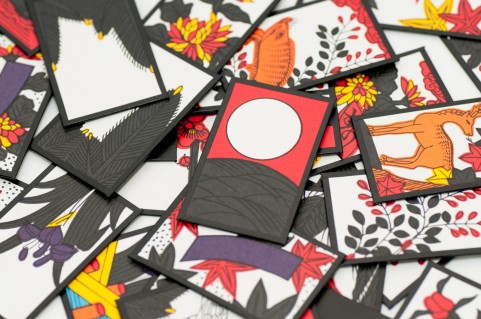
「花札」とは、日本のかるたの一種で、松・梅・桜・藤・菖蒲 (あやめ)・牡丹・萩・芒 (すすき)・菊・紅葉・柳・桐の12種を描いた札をそれぞれ4枚ずつ1月から12月に当てた48枚の札を使うカードゲームです。「花かるた」ともいいます。
playing cards with pictures of flora such as pine, Japanese apricot tree, cherry blossom, wisteria, willow, and paulownia representing the four seasons
(松、梅、桜、藤、柳、桐などの四季の代表的な花樹が描かれたカードゲーム)
The playing cards that the Portuguese introduced to Japan in the 16th century developed into Hanafuda.
(花札は、16世紀にポルトガル人によって日本に伝えられたカードゲームが発展したものです。)
Hanafuda, a traditional Japanese card game, consists of 48 cards, twelve sets of four cards corresponding to each month of the year.
(花札とは、日本の伝統的なカードゲームで、4枚1組をそれぞれの月ごとにあてた計48枚のカードから成っています。→ corresponding「対応する・一致する」)
A popular game player with Hanafusa cards is called “koi koi.”
(一般的な花札の遊び方は「こいこい」と呼ばれています。)
Players compete to form special card combinations called “yaku” (or sets).
(プレイヤーは、「役」と呼ばれる特別な組み合わせをつくることで競い合います。)
羽根突き

日本のお正月などに行われる、特に女の子の伝統的な遊びのひとつで、ムクロジの実に羽根を付けたものを、装飾が施された木製の羽子板で突き合います。
英語では traditional Japanese badminton などと訳され、羽根突きやバドミントンに使われる「羽根」は、shuttlecock といいます。
Hanetsuki is played by (young) girls at the beginning of New Year and resembles badminton.
(羽根突きは、お正月の女の子の遊びで、バドミントンに似ています。)
Hanetsuki is a game similar to badminton that uses boards like rackets and a wing.
(羽根突きとは、バドミントンに似た遊びで、ラケットのような板と羽根を使います。)
Hanetsuki is a traditional Japanese play similar to badminton without a net, played with a rectangular wooden board/paddle called “hagoita” and a shuttlecock.
(羽根突きは、ネットのないバドミントンのような日本の伝統的な遊びで、「羽子板」と呼ばれる長方形の板と羽根を使って遊びます。)
凧揚げ

江戸時代に長崎の出島から日本に持ち込まれたといわれている凧揚げは、日本ではお正月の風物詩として親しまれています。
国際大会も行われており、アジアをはじめとする世界各国の力作の凧が空を彩る様子は圧巻です。
英語では、凧は kite で、凧揚げは kite-flying といいます。
a kite made by pasting Japanese paper on a bamboo framework
(竹製の枠組みに和紙を貼ってつくった凧)
A Japanese kite is made with paper glued on a bamboo frame, and pictures of samurai or Kabuki actors are drawn on the surface together with Japanese writing.
(日本の凧は、竹の骨組みに紙を貼り、表面に武士や歌舞伎役者の絵や文字が描かれています。)
One flies a kite high into the sky using the wind force.
(風力を利用して空高く揚げます。)
けん玉
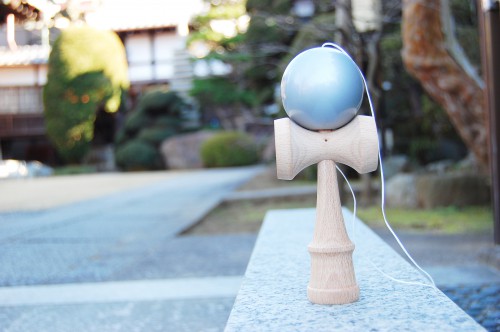
けん玉は既に英語化していますので、Kendama でも通じますが、英語では cup and ball または ring and pin などと言います。
けん玉のルーツは16世紀頃のフランスのビル・ボケという玩具であることが定説となっており、日本においては江戸時代に酒席の余興であった記録が残っているそうです。
アメリカやメキシコ、スペインなど世界各国にけん玉のおもちゃがあり、形状は異なるものの遊び方はほぼ同じで、古くから親しまれていることがうかがえます。
Kendama is a wooden toy made up of a ball tied to a handle by a cord.
(けん玉とは、持ち手と糸でつながれたボールでできた木製の玩具です。)
A kendama consists of a hammer-like handle, three cups, and a ball with a hole.
(けん玉は、ハンマーのような持ち手、3つのお皿、穴の空いたボールから成っています。)
Kendama is a wooden toy consisting of a stick crossed with one of its tips sharpened, the other three ends dish-shaped, and a ball with a hole in it connected to the handle by a string.
(けん玉とは、十字のかたちをした棒の先端を尖らせ、他の三方を皿状に加工し、そしてボールを組み合わせた木製のおもちゃで、ボールには穴が空いており持ち手と紐で繋がっています。)
Kendama is played by tossing into the air a ball attached to a cord and then catching it on the cups or the spike.
(けん玉は、紐が付いたボールを空中に投げて、皿や先端でキャッチしたりして遊びます。)
The game is played by swinging the ball and then fitting a spike into a hole in it or landing it on one of three saucers.
(ボールを振り上げ、先端をボールの穴に差したり、3つの受け皿の1つに着地させたりして遊びます。)
One tries to get the sharp/spike into the hole or to catch the ball on each of the cups.
(ボールを先端に刺したり、カップでキャッチしたりして遊びます。)
Kendama championships are held and it is fun entertainment to watch superb techniques of good players.
(けん玉選手権もあり、名人の巧みなテクニックは優れたエンターテインメントとなっています。)
Players compete with each other in their skill at landing the ball on each of the cupped surfaces of the handle and on the spike on its top.
(プレイヤーは、ボールを柄のお皿にのせたり先端に入れる技術を競い合います。)
お手玉
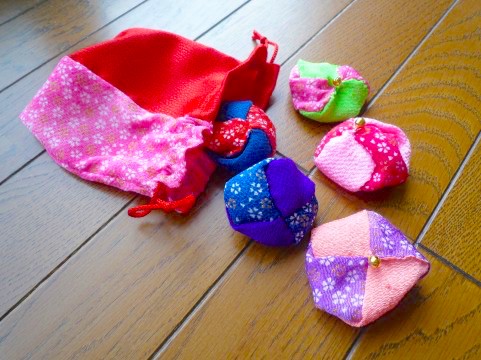
古くから女の子の遊びとして親しまれてきたお手玉は、一見簡単なようで意外と難しく、脳の活性化にも良いとのことで、世代を超えて楽しむことができます。
見た目が可愛らしいので、お好みの和柄の生地を使ってお手玉を手作りする方も多くいらっしゃるようです。
一般的に、お手玉は英語で tossing beanbags と訳されます。
Otedama is said to have originated in Ancient Greece and it came to Japan in the Nara Period from China.
(お手玉は古代ギリシャが発祥といわれており、奈良時代に中国から日本に伝わりました。)
Otedama is played with small bags which are made of cloth and filled with adzuki beans or rice.
(お手玉とは、布でできた小さな袋に小豆やお米などを詰めたものを使って遊びます。)
Otedama is a traditional Japanese children’s game with bean bags of the size comfortably held in a hand, which are tossed and juggled in a game similar to jacks.
(お手玉とは、伝統的な日本の子供の遊びで、手のひらサイズの豆袋をジャグリングのように投げます。)
One plays by tossing up bean bags continuously to a song, and it is a game similar to juggling in a street performance.
(歌に合わせて豆袋を次々に投げる、大道芸のジャグリングに似た遊びです。)
・similar to:〜に似た
・comfortably:❶心地よく、快適に ❷ゆうゆうと(収まるなど)
